The prototype. In the United States, steam locomotives with 2-8-0 wheel arrangements first appeared in the post-Civil War years. Like other locomotives of that time, a key to the design’s success was a two-wheel pilot truck. Also called the Consolidation type, the 2-8-0 became the primary mainline freight locomotive in North America and remained so into the early 20th century.
Eventually the Consolidation became this country’s most numerous locomotive type. New 2-8-0s were built as late as the 1930s and included “modern” features like superheaters, electric lights, and larger boilers and cylinders. By that time, most railroads had relegated their Consolidations to branchline and other light-duty service, but many 2-8-0s rolled on through the end of the steam era in the 1950s.
The model. Like the Spectrum version, the Sound Value 2-8-0 is based on a Baldwin-built Illinois Central 900-class 2-8-0 that was rebuilt by the IC in the late 1930s. The model’s dimensions closely follow prototype drawings published in the Model Railroader Cyclopedia: Vol. 1, Steam Locomotives (Kalmbach Publishing Co.).
The model has some detail differences compared to the IC prototype that give it a more generic look, including an oval sand dome and a 32-foot United States Railroad Administration-style tender.
The plastic model features sharply defined boiler bands, rivet seams, and other molded detail. The handrails, piping, and air compressor are among the separately applied detail parts.
The cab interior includes a detailed backhead and painted crew figures. There’s clear glazing in the cab windows.
Our review sample is decorated in a freelanced paint scheme as New York Central no. 1137. The Central had many Consolidation-type steamers, but they followed different proportions than the Bachmann model. All the lettering is clearly printed in NYC’s post-1940 “modern” font.
The mechanism. The flywheel-equipped motor is enclosed by a metal weight that fits inside the plastic boiler. The motor drives the worm gear via a rubber belt. The worm gear engages the third driver axle while the locomotive side rods transfer power to the other driver axles.
After removing a single screw on the tender chassis, I lifted off the plastic tender shell. A downward-facing, round 28mm speaker is mounted to the bottom of the tender chassis. The Sound Value decoder is above the speaker. There are also die-cast metal weights attached to the chassis above each tender truck.
A wiring harness connects the decoder to the motor, headlight, and track power pickups in the locomotive.
After setting the decoder to 128 steps, the engine crept along at 1 scale mph in speed step 1. The decoder’s supported configuration variables (CVs), include those for fine-tuning the model’s performance with speed tables as well as acceleration and deceleration momentum.
During real-world testing on our DCC-controlled staff layout, the Milwaukee, Racine & Troy, the Bachmann 2-8-0 proved to be a capable workhorse. The locomotive rolled through no. 5 and 6 turnouts without so much as a headlight flicker.
On the 3 percent climb to Sky Ridge, the Consolidation hauled a 10-car freight train without slipping. On straight and level track the locomotive can handle about 38 free-rolling HO freight cars.
On our DC test track, powered by a Model Rectifier Corp. Tech 4 power pack, the Bachmann 2-8-0 didn’t start moving smoothly until I applied 7 volts to the track. At that point the model was traveling at 17 scale mph. The locomotive then accelerated smoothly as I advanced the throttle, reaching a speed of 75 scale mph at 12V, the maximum used for our DC speed tests.
I improved the locomotive’s low-speed performance in DC by using our DCC system to set the decoder’s analog starting voltage (CV 63) to a value of 2. At that setting the model started rolling smoothly at 12 scale mph when I set the DC power pack to 6V. For those without a DCC system, these CVs can also be set with an analog programmer, such as an MRC Tech 6.
Sound Value. The Sound Value decoder offers the excellent, realistic sound reproduction of a top-of-the-line SoundTraxx decoder, but has simplified function and programming options. Unlike the Tsunami or Econami, the Sound Value decoder doesn’t have Digital Dynamic Exhaust or button-controlled braking.
However, I could still use a DCC throttle to trigger many sound effects, including the bell, long and short whistle blasts, and a steam release. In addition to a master volume control (CV128), there are other CVs that allowed me to set the volume levels of individual sounds.
Function 0 turns on the headlight, which shines brightly when the locomotive’s direction is set to forward and automatically dims when the direction is set to reverse. There’s also a manual headlight dimmer that’s programmed to function 7 by default. All the available functions can be remapped if desired.
Out of the box, the model’s exhaust chuffs were out of synch. I easily fine-tuned the chuffs using CV 116. After some trial and error I found that a value of 121 provided the correct four chuffs per wheel revolution.
Free user manuals are available for download at www.soundtraxx.com.
In DC the available sound effects are automatic. With power to the track I heard the air pumps. As I advanced the throttle I heard the exhaust chuff. When I moved the throttle quickly, a grade crossing whistle signal sounded. Other automatic whistle signals or other sound effects can be added or turned off by programming CV 197 with either a DCC system or analog DC programmer.
Looking right at home hauling a local or other pike-size freight train, the Bachmann Sound Value 2-8-0 is a great choice for rounding out an HO steam roster.
Manufacturer
Bachmann Trains
1400 E. Erie Ave.
Philadelphia, PA 19124
www.bachmanntrains.com
Era: 1930s to 1950s (as detailed)
Road names: New York Central; Atchison, Topeka & Santa Fe; Pennsylvania; Southern Ry.; and Union Pacific
Features
• Die-cast metal chassis
• Electrical pickup on eight drivers and four tender wheels (two per side)
• Front and rear plastic E-Z Mate Mark II knuckle couplers at correct height
• Light-emitting diode headlight
• Minimum radius: 18″
• Precision motor with brass flywheel
• RP-25 contour metal wheels in gauge
• SoundTraxx Sound Value dual-mode decoder
• Weight: 1 pound, .5 ounce (Engine alone weighs 13 ounces)





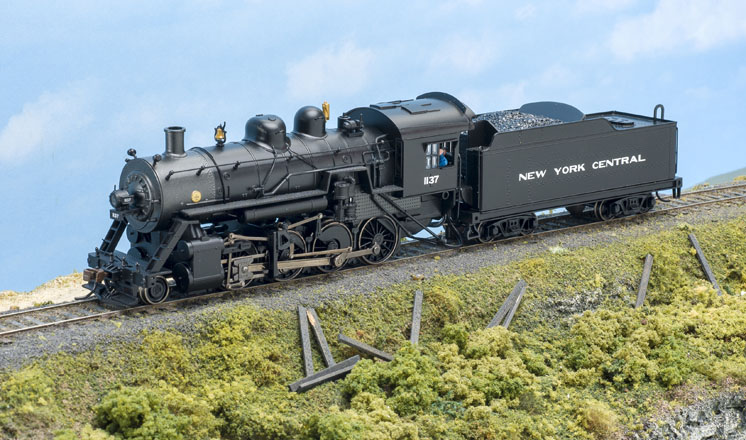
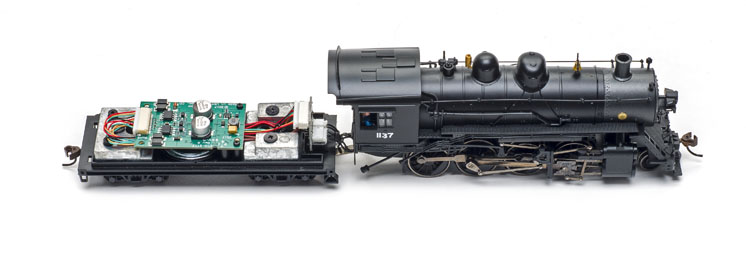
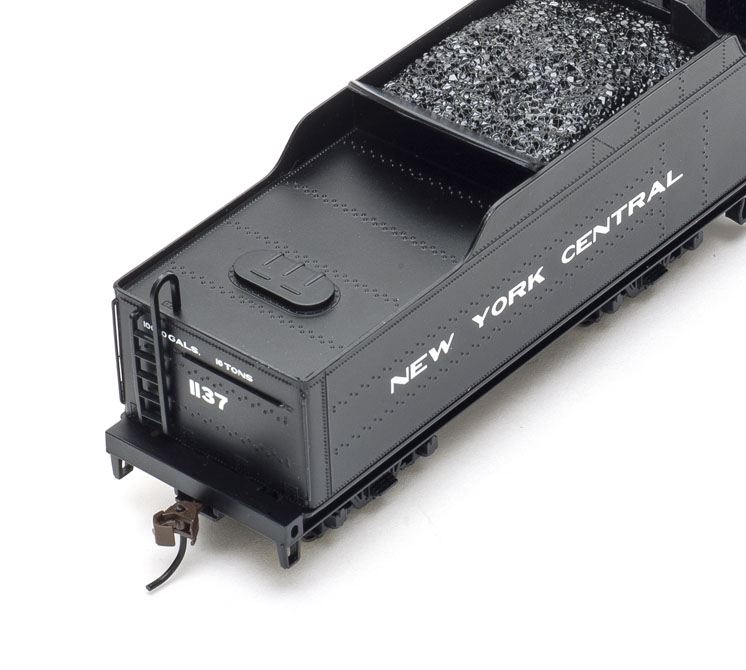
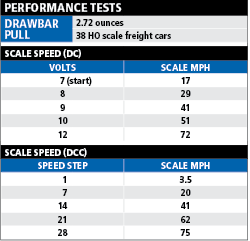


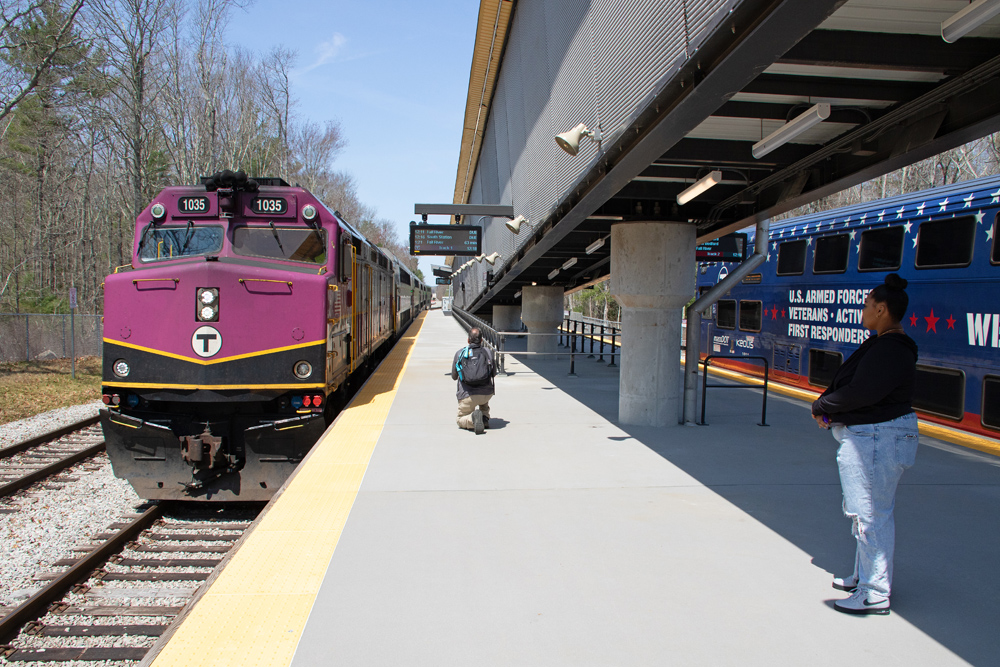






Bachmann tenders have connections from each truck to the decoder via a tab on the truck bolster screw. I normally disconnect these wires and instead solder the wire ends directly to each truck wiper. I drill a small hole near the bolster and thread the lead through the tender base. Much better pickup.